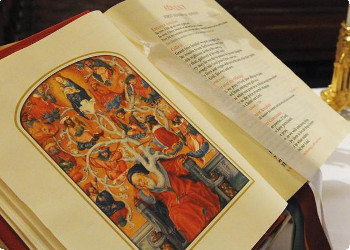He bent down and saw the burial cloths there, but did not go in
27 DICEMBRE (Jn 20,2-8)
The sign for John is more eloquent than words. It is a true way and door of faith. All of his whole Gospel is based on the sign and also his faith in Christ finds its one true, foundation on the sign. He himself is the one to affirm it with very clear words.
Now Jesus did many other signs in the presence of (his) disciples that are not written in this book. But these are written that you may (come to) believe that Jesus is the Messiah, the Son of God, and that through this belief you may have life in his name (Jn 20,30-31).
After the resurrection it is by the sign that he recognizes that Jesus is on the shore of the Sea of Galilee. Where the other disciples see a foreigner, he sees Jesus and says it to Peter. In this John has really special, particular and unique eyes. He only needs a few clues, small events, short stories, and he immediately enters the truth of the mystery.
After this, Jesus revealed himself again to his disciples at the Sea of Tiberias. He revealed himself in this way. Together were Simon Peter, Thomas called Didymus, Nathanael from Cana in Galilee, Zebedee’s sons, and two others of his disciples. Simon Peter said to them, “I am going fishing.” They said to him, “We also will come with you.” So they went out and got into the boat, but that night they caught nothing. When it was already dawn, Jesus was standing on the shore; but the disciples did not realize that it was Jesus. Jesus said to them, “Children, have you caught anything to eat?” They answered him, “No.” So he said to them, “Cast the net over the right side of the boat and you will find something.” So they cast it, and were not able to pull it in because of the number of fish. So the disciple whom Jesus loved said to Peter, “It is the Lord.” When Simon Peter heard that it was the Lord, he tucked in his garment, for he was lightly clad, and jumped into the sea. The other disciples came in the boat, for they were not far from shore, only about a hundred yards, dragging the net with the fish. When they climbed out on shore, they saw a charcoal fire with fish on it and bread. Jesus said to them, “Bring some of the fish you just caught.” So Simon Peter went over and dragged the net ashore full of one hundred fifty-three large fish. Even though there were so many, the net was not torn. Jesus said to them, “Come, have breakfast.” And none of the disciples dared to ask him, “Who are you?” because they realized it was the Lord. Jesus came over and took the bread and gave it to them, and in like manner the fish. This was now the third time Jesus was revealed to his disciples after being raised from the dead. (Jn 21,1-14).
What for the other disciples is harmless everyday life, without any particular meaning, for John it is a sign of the presence of Jesus. A net that gets filled in an empty sea is a proof that the Word is only of Jesus. It cannot be of others. This dynamic of the faith must always be observed. Without the sign the faith can never be born. If it is born, it is certainly not a vital faith. It remains an abstract truth, out of man, far from his history, useless for his life.
So she ran and went to Simon Peter and to the other disciple whom Jesus loved, and told them, “They have taken the Lord from the tomb, and we don’t know where they put him.” So Peter and the other disciple went out and came to the tomb. They both ran, but the other disciple ran faster than Peter and arrived at the tomb first; he bent down and saw the burial cloths there, but did not go in. When Simon Peter arrived after him, he went into the tomb and saw the burial cloths there, and the cloth that had covered his head, not with the burial cloths but rolled up in a separate place. Then the other disciple also went in, the one who had arrived at the tomb first, and he saw and believed.
John does not believe in risen Jesus because he sees, touches him and hears his voice. He believes without seeing. Only a few clues are enough to him in an empty tomb for his faith to be perfect. What he sees in the place where Jesus had been laid attests to his spirit that there was no theft of the body of the Lord. In that room carved into the rock harmony, order, peace, silence and composure reign. It is as if everything had been operated by a skilful, intelligent and calm hand. Only one is able to do all these things: Lord Jesus and he did them coming back to life. Along the course of the centuries we have passed from the sign to the rationality of the truths of faith and everything has been miserably impoverished. The sign speaks to every heart. Rationality does not speak to anyone. The sign attests to the vitality of the faith. The theological rationality indicates its death.
Virgin Mary, Mother of the Redemption, Angels and Saints make us operators of signs of faith.





